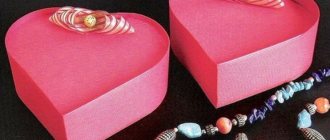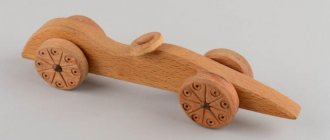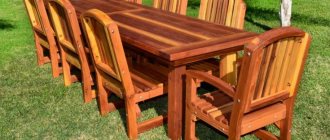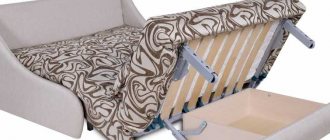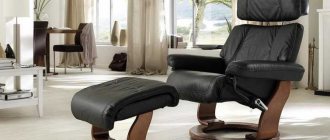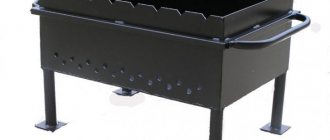The summer season is approaching and it's time to think about creating a chaise lounge with your own hands. It will allow you to enjoy your outdoor recreation to the fullest.
Chaise longue in French means long chair. This is a chair for relaxing. It can, at the owner’s request, change the position of the backrest.
DIY chaise longue
- 1 General recommendations
- 2 Monolithic chaise lounge made of wood
- 3 Assembling a chaise lounge on wheels
- 4 Simple lounger
- 5 Video of DIY garden lounger
- 6 Fabric chaise longue
- 7 DIY fabric chaise lounge. Model 2 7.1 Manufacturing process:
- 7.2 Model installation
- 9.1 Pay attention to another interesting chaise lounge model in the video.
- 10.1 Installation of the Kentucky chair
- 12.1 Unusual do-it-yourself deck chair
- 13.1 DIY pallet lounger video.
Sun loungers are widely used on beaches and by pools. On personal plots, dachas.
Sun loungers are made from various materials:
- wood;
- plastic;
- aluminum;
- rattan;
- PVC pipes;
- durable fabric.
Wooden sun loungers are the most popular and environmentally friendly. They come in a variety of shapes and designs. The disadvantage of monolithic wooden sun loungers is their weight. But this problem can be solved with the help of wheels.
Plastic sun loungers are characterized by easy mobility, ease of maintenance, and relatively low cost. Their minus is their fragility.
Fabric loungers are versatile and comfortable. Their frame is made of wood, metal or PVC pipes. They fold easily and do not take up much space.
Rattan sun loungers look great in the lap of nature. They are environmentally friendly. However, purchasing them is expensive. If you have sufficient skills, you can simply weave a rattan lounger yourself.
In this article we will tell you how to create wooden sun loungers with your own hands.
General recommendations
To ensure the longevity of the effort expended, the materials used must be processed.
Antiseptics and special impregnations will help protect wood from moisture, harmful insects, rot, and mold. It is better to carry out processing before assembling the structure.
After installing the sunbed, the wooden parts should be coated with primer, drying oil, varnish or paint. This will extend the life of your masterpiece.
Fabrics should also be protected from rain and sun. Water-repellent impregnations will help preserve their brightness and service. Their effect lasts 2-4 weeks.
And, of course, remember the famous Russian proverb when working. Measure seven times, cut once.
Monolithic chaise lounge made of wood
Solid models are heavy. Therefore, to make it easier to carry, wheels are added to the headboard. The following instructions will help you make a chaise lounge on wheels with your own hands.
You will need tools:
- electric jigsaw or hacksaw;
- drill;
- screwdriver;
- self-tapping screws;
- fine grain sandpaper;
- spirit level;
- roulette.
When choosing a tree, pay attention to coniferous species. They are sold at affordable prices and are characterized by increased water resistance. Materials needed for a sun lounger:
- glued slab made of wood, its thickness should be 2 cm or more; at least 2 cm thick.
- boards 0.25 cm thick.
- wooden beam with a square section of 50x50 mm;
- 4 wheels with a diameter of 10cm;
- corners for strengthening the bed;
- door hinges;
- varnish or paint.
We suggest you make a chaise lounge according to this pattern.
Legend:
- Front legs.
- Hind legs.
- Bearing longitudinal.
- Back support.
- Back support.
- Bearing transverse.
- Fixing bar.
- Backrest support.
- Wheels.
- End beam.
- Back slats.
- Seat slats.
- The support beam is transverse.
- Fixing bar.
You can independently determine the size of the desired sun lounger and make calculations. Or use the standard size 60x190 cm. It is the most optimal and ergonomic for the average adult.
Chaise lounge with fabric
In addition to the usual wooden chaise lounge, you can make a seat with fabric. To produce it, we will also need wooden blocks, durable fabric, fastening materials, a pneumatic drill, glue and sandpaper.
For this type of chaise lounge, it is recommended to use tree species such as oak or birch.
The best fabric option in this case is denim or canvas, as they do not fade in the sun, and they are also not afraid of wet weather. When choosing such fabrics, your chaise lounge will retain its presentable appearance for many years.
Assembling a chaise lounge on wheels
We assemble the base frame from the bars. We secure the load-bearing parts with corners similar to those that secure the base of the bed.
We sheathe the resulting frame with pre-prepared and sanded boards.
We make blanks for the legs from timber. Their height usually ranges from 5-10 cm. Choose one that is comfortable for yourself and your household.
We drill holes with a drill, retreating 5-7 cm from the ends of the longitudinal sides. We secure the legs with long bolts. We control the horizontal side with a spirit level.
We screw the wheels to the center of the legs with bolts with a diameter of 30mm.
Let's start cutting the lattice elements. Use a hacksaw or jigsaw to cut 8x60cm boards.
Using self-tapping screws and a screwdriver, screw the slats to the chaise lounge frame. Since the boards are not screwed tightly, we use spacers to obtain even gaps.
We should have two parts. The smaller one is intended for the headboard. We connect both grilles with door hinges. We install a support bar under the opening part.
All that remains is to sand off the production flaws. Apply wood primer. Paint it in your favorite color and the chaise longue with your own hands is ready.
For a more comfortable stay, you can sew additional mattresses that fit the size of the bed.
Simple sun lounger
To create a wooden chaise lounge with your own hands, you need the following materials, as well as tools:
- tape measure and square;
- pencil;
- saw;
- electric drill;
- screwdriver or screwdriver;
- screws, self-tapping screws and studs for fixation;
- sandpaper or grinder;
- wood putty;
- dye.
Wooden beams used in the work:
- for the back of the chaise lounge, take boards 5×10 with a length of 88 cm - 2 pieces, 39 cm - 3 pieces, 60 cm - 1 piece;
- 2 longitudinal bars for a frame 215 cm long;
- 2 cross beams -50 cm;
- 6 legs -35 cm;
- 13 slats for a seat measuring 2.5 x 8 x 60 cm;
- 6 slats for the back - 2.5? 8? 88 cm.
The first priority is to create a very strong frame. We take two parts 215 cm long, connect them with screws to half-meter transverse parts.
Let's move on to sitting. Take all the 60 cm slats. Attach them to the frame with self-tapping screws, leaving small gaps. To ensure that the gaps are even and uniform, use spacers 1 cm thick.
We create the legs of the lounger. To give maximum stability to the chaise longue, two legs are nailed at once at the legs. One at a time at the head. The instructions indicate bars with a height of 35 cm. But you can choose a height that is comfortable for you
We make the back from 2 boards measuring 88 cm and 3 boards measuring 39 cm. The resulting frame should easily fit into the base, leaving a small gap between the structures.
We securely fasten the longitudinal strips. We round them for a more beautiful look.
Attach the backrest to the base of the lounger. To do this, you need to drill holes at a distance of 9cm from the edge of the seat. Secure with pins.
We make 2 grooves at the base of the sun lounger for the support bars. The first 5x10 cm notch should be approximately 9 cm from the stud. The second is 20cm from the first. But its depth will be only 5x5 cm.
A 60cm beam is inserted horizontally into the first recess. To change the position, the board is transferred vertically to the second recess.
Sand all rough edges and imperfections. Process it. Cover with paint or varnish. The chaise lounge is ready with your own hands.
Care of the finished product
The service life and functionality of a country lounger largely depends on proper care for it . To ensure that it brings only pleasure to the owner for many years, the following activities should be carried out regularly:
- wet cleaning of textile elements;
- lubrication of folding mechanisms;
- timely painting.
For the winter, it is recommended to put the homemade chaise lounge indoors. This will further increase its service life and will allow you to use it in the country for many more years.
Many of our compatriots who own dachas arrange their holidays there in different ways. You can often find wooden sun loungers in their areas, which provide them with excellent conditions for relaxation. For the most part, these are home-made structures that can be made with your own hands, even without experience in the construction field. Due to the simplicity of the design, sun loungers can be made from available material. But it’s still not worth starting such work without a drawing.
It is also recommended to find out in advance exactly what tools will be needed and how much material is needed, so that when making a wooden chaise longue with your own hands, you can achieve even greater savings.
Fabric chaise lounge
A chair with a frame complemented with fabric is one of the most comfortable, budget types of chaise lounges. It is convenient to fold and easy to carry. Can be stored flat. It takes up little space.
To create a sun lounger with your own hands you will need:
- bolts, nuts with a diameter of 8 cm;
- small nails with round heads;
- round sticks (1 piece -65cm, 2 pieces - 50cm, 2 pieces -60cm);
- rectangular bars 25x60cm thick (2 pieces 120cm, 100cm and 60cm long);
- needle file, fine-grain sandpaper;
- glue;
- durable material measuring 200 by 50 cm.
Choose materials carefully so that your work is not in vain. Hardwood blocks are perfect for a sun lounger. Choose:
- birch;
- oak;
- beech.
Choose fabrics with maximum strength. Great fit:
- teak for mattresses;
- tarpaulin;
- canvas;
- camouflage;
- denim
These materials have increased wear resistance and will last you a long time. Let's move on to creating a sun lounger with our own hands. The base consists of three frames:
- A.1200x600 mm.
- B.1100x550 mm.
- H.650x620 mm.
Cut the boards to the required length. We sand with sandpaper.
In the longitudinal bars we make indents of 70 and 40 cm, and drill holes with a diameter of 8 mm with a drill, just like the bolts. Sand with a round file.
We make cutouts in part B. They will allow you to change the position of the back later. To do this, retreat 7-10 centimeters. It is necessary to cut 3 or 4 recesses. We polish well.
According to the diagram, we drill holes in the bars to connect the parts.
Assembling the base of the lounger. We connect frames A and B using screws. Then we connect frames A and B. For greater reliability, we lubricate the ends of the round slats with PVA before assembly. The frame of the sun lounger is ready.
Now you need to sew the seat. Place the material on the bed in the folded position. The fabric should be slightly stretched. Measure the desired length. Hem the edges. This way you will increase the wear resistance of the material. The chair will look neater.
We attach the fabric base to the lounger. We wrap round slats on parts A and B. We nail them with small nails with round heads. The chair is ready.
ADVICE. The edges of the fabric base can be made in the form of loops. In this case, the seat is simply strung on slats.
What types of sun loungers are there?
There are several types of designs for this type of furniture:
1. Monolithic.
2. Portable.
3. Soldered, with inserts.
Monolithic chaise longue. During the production of this type of furniture, the parts of the chair are combined with each other. And in the future, the chaise lounge cannot be disassembled, making it strong, stable and durable.
The downside of this chaise lounge is that it is impractical; it cannot be folded and there is no backrest adjuster. Transporting such a chair will be difficult for you.
Portable sun lounger. This type of furniture has many advantages; it is compact and practical. You can easily adjust the position of the chair thanks to a special mechanism.
Soldered chaise longue with inserts. A self-made chaise longue will undoubtedly be attractive and practical. Additional inserts from other materials reduce the durability and durability of the product, this is a disadvantage.
Required material for a wooden sun lounger:
- Wood board with a thickness of 2 cm.
- Short boards 0.25 cm and blocks 0.45×0.45 for making a frame.
- Tools that will come in handy (screwdriver, handsaw or jigsaw).
- Drills with a diameter of 0.4 cm.
- Angles and sheets for sanding.
- Wood varnish and paint.
Sheets made of wood and pine needles are best suited for self-production. This wood is moisture resistant and can be easily found in any hardware store.
DIY fabric chaise lounge. Model 2
For this chair you will need:
- wooden slats measuring 2x4 cm. Two slats each with a length of 122cm, 112cm, 38cm. One piece each 61 cm, 65 cm, 57 cm. And four slats 60cm long;
- slats measuring 2x6 cm. One each 61 and 57 cm;
- 65cm wooden rod with a diameter of 1.2cm;
- a piece of fabric 137 cm long and 116 cm wide;
- bolts, washers, nuts, screws;
- glue;
- round needle file, sandpaper or grinder;
- electric drill.
Manufacturing process:
Process all the details of the future chair in advance. Sand them using a machine or fine-grained sandpaper. Cover with special impregnations that protect the wood from corrosion. Appreciate your work.
Pay attention to the drawing. The crossbars at the bottom of the legs help fix the position of the backrest. Make them. Or cuts, retreating from the edge by approximately 20, 25, 30 and 35 cm.
Drill holes for the bolts in the back frame. To do this, measure 41cm on each side.
On the seat frame, step back 43cm from the top. Make holes.
On the piece supporting the back, drill holes in the center of the edges.
Process all holes with a round file.
Model installation
First assemble the back frame. A beam 61 cm long will carry a large body load. Secure it as securely as possible. Leave a small gap between the two slats. The tissue will be fixed through it.
Assemble the seat. Fold it with the back frame. Be sure to place a washer between them. Bolt the frames together.
ADVICE. To prevent the nuts from loosening quickly, tighten an additional lock nut on top. For greater reliability, attach the nuts to glue, varnish or paint. First tighten the nut. Then loosen it slightly so that the parts rotate freely.
Install the back support piece using washers and bolts.
Sand away all imperfections. If desired, varnish or paint.
Fold the fabric in half, sew, retreating 1.5 centimeters from the edge. Turn it inside out. Fold the edge of the material for the rods that secure the panel between the slats. Sew.
Now insert the material between the slats. Secure with a rod. This installation model allows you to remove the fabric for washing without much effort.
Folding chaise lounge with fabric seat
A folding chair is more convenient, since moving it will not be difficult, and in rainy weather it can be easily folded and hidden (which is important for wooden products). With just one move, you can turn your lounge chair into a comfortable chair.
Materials
Dimensions
So, the materials we need are:
For the back legs:
- 2×4×122 cm – 2 pcs.
- 2×4×61 cm – 1 pc.
- 2×4×65 cm – 1 pc.
- 2×6×61 cm – 1 pc.
For seat legs:
- 2×4×112 cm – 2 pcs.
- 2×4×60 cm – 4 pcs.
- 2×4×57 cm – 1 pc.
- 2×6×57 cm – 1 pc.
Back support:
- 2×4×38 cm – 2 pcs.
- Wooden rod with a diameter of 1.2 cm, a length of 65 cm - 1 pc.
Fabric seat:
- Fabric 137×116 cm.
- Wooden rod with a diameter of 1.2 cm, a length of 55.9 cm - 2 pcs.
To secure parts:
- Bolts and nuts – 4 pcs.
- Washers (for the bolt head and nut) – 8 pcs.
- Carpenter's glue.
- Screws.
Tools:
- Drill.
- Sandpaper or sanding machine.
- Round needle file.
Preparatory processes
All parts must be pre-treated, namely sanded and treated with special impregnations to protect the wood from corrosion. Then the product will serve you much longer.
As can be seen in the drawing, crossbars are installed at the bottom of the seat legs, thanks to which the position of the backrest is fixed. If you plan to install only one plank, you should first make cuts in place of the planks: 20 cm from the edge, then 25, 30 and 35. Also on the back frame you need to make holes for bolts, retreating 41 cm on each side. On the seat frame you should retreat 43 cm from the top. And on the support of the back of the chaise, make a hole in the center from the edges.
Frame assembly
Back frame
First of all, the back frame is assembled. A plank with a size of 2x6x61 cm will bear the main load, so special attention should be paid to its fastening. Its fixation should be done as securely as possible. Be sure to leave a gap of 1 cm between the two slats. This will be necessary for attaching the fabric.
Seat frame
Based on the above diagram, assemble the seat frame. After this, fold the frame of the back and seat. First, drill holes on the back frame from the top bar on both sides at a distance of 41 cm, and on the seat 43 cm. Fasten them with bolts and a nut. Be sure to place a washer between the frame posts.
Aligning holes
During operation, the nuts may become loose. To prevent this, tighten one more locknut at a time. Nuts can also be mounted with Moment paint or glue. To adjust the free play, first tighten the nut and then loosen it slightly. After this, let the glue/paint dry.
Connecting frame elements
Now you can install the backrest support. Attach the slats to the back with bolts and use washers in the same way. A large dowel is pressed into the prepared hole in the planks using glue.
The fabric for the seat should be strong enough. Canvas, tarpaulin, jeans and other types of wear-resistant fabrics are suitable.
The fabric should be folded in half and stitched, retreating 1.5 cm from the edge. Then we turn it inside out. We bend the edge of the fabric for the rod that secures the fabric seat between the slats and stitch it. We do the same with the reverse edge.
Then the edge of the fabric should be inserted between the slats and a rod should be installed in the fold. This way, the seat will be firmly fixed, but at the same time removing it for washing will not be difficult.
Final proceedings
Ready-made folding chaise longue with fabric seat
At the final stage of manufacturing the sun lounger, it is advisable to eliminate the remaining or formed irregularities and roughness with a file or sandpaper. After this, if desired, the product can be coated with paint or varnish.
Of course, using this design, you have many opportunities to improvise. For example, instead of a fabric seat, you can simply install more slats all the way up to the joint. It depends on your preference.
Chaise lounge made of polyvinyl chloride
Another example of a lounger with a fabric base. Only in this case, wooden slats are replaced with PVC pipes. Chair sizes may vary.
In this do-it-yourself chaise lounge model we used:
- 2-inch polyvinyl chloride pipes;
- L-shaped connectors – 8 pieces;
- T-shaped connectors – 6 pieces.
First, connect 30cm and 45cm long PVC pipes for the vertical strip using a T-connector. Place L-shaped connectors on the ends. Connect the second vertical in the same way.
Now you need to connect the two sides together. Please note that one horizontal crossbar is solid. Its length is 66cm. It is attached closer to the T-shaped connection, which in turn should be directed into the structure. The second side consists of two 30cm pipes, combined with a T-shaped adapter, turned at an angle of 45 degrees from the long side of the strip.
Do not hurry. Measure pipes accurately. As a result, you should end up with a rectangular structure.
Now is the time to make the connection on which the seat will rotate. To do this, insert a 5cm long pipe into the T-shaped connector and secure it with another T-shaped adapter. It will become the basis of the horizontal frame.
Make the long sides similar to the vertical section, using 30 and 45 cm pipes with an L-shaped connector. For crossbars, use a solid tube 30cm long. And also consisting of 2 x 20 cm with a T-shaped adapter.
You did everything right if you get a rectangle within a rectangle.
The seat is located between a long section of the vertical section and a short section of the horizontal section. Adjust the level of inclination that is comfortable for you. Measure the distance between the two free T-pieces. Cut the pipe to the required length. Insert the rear support.
Take measurements of the fabric consumption for your chair. Use thick fabric. For example, canvas, tarpaulin, jeans. Hem the edges and secure the fabric to the chaise lounge. Enjoy your holiday.
Portable lounge chair
The durable, lightweight chair is quickly assembled and disassembled. It is convenient to take it with you outdoors. The model is so easy to make that it is suitable even for novice craftsmen.
The collapsible chair consists of 2 parts:
- backrest covered with dense, wear-resistant fabric;
- wooden seat.
To create a chair, it is recommended to take cherry boards for the upper crosspieces and seat, as well as maple for the legs and supporting parts. You can also use pine wood.
In addition to tools, the following materials are used:
- 2 legs for the backrest measuring 20x40x800mm;
- 2 legs for the seat - 20x40x560mm;
- 2 lower crossbars - 10x50x380mm;
- 1 top crossbar - 10x40x380mm;
- 1 seat crossbar - 20x40x300mm;
- 5 slats - 20x40x400mm;
- piece of material - 600x500mm.
The procedure for assembling a portable sun lounger is shown in the diagram.
First, the parts are connected using self-tapping screws and a screwdriver.
The workpiece is processed and varnished.
While the frame dries, the fabric is folded and stitched. Then it is nailed using staples and a construction stapler to a wooden piece.
We connect the back and seat of the chaise lounge.
Enjoying your holiday in your new armchair.
Pay attention to another interesting chaise lounge model in the video.
Chaise lounge made from pallets - master class and photo
These pallets can also be used to make an excellent chaise lounge. If you want, attach wheels to it on one side to lift it on the other and take it to any place.
To make a chaise lounge of this type, you will first need to connect two pallets. To do this, first make a base from boards, then attach wheels here on one side, and fix two pallets on top using self-tapping screws and corners. You will also need a third pallet. It needs to be modified a little to fit the boards tightly together.
Nail this piece perpendicular to the first two. You will have a chaise lounge and a mobile bed on wheels at the same time. If you want the backrest to recline, you need to knock down 2 pallets, and from the third, remove part of the boards on one side and remove the block from the same side.
You have formed half a pallet with two long legs, with the help of which you will fix this part to the base. Secure it using furniture staplers.
To keep the back well in this position, attach two boards to the back, which will rest on the ground on the reverse side.
If you wish, paint your creation. You can sew a mattress on it and put it on this chaise longue so that it is soft to lie on. And from the round part of a wooden reel you will make a table for such a resting place.
There is another option for a chaise lounge, this is the Kentucky chair. It is mobile and can be unfolded according to your wishes so that you can have a great rest on it.
- See also how to restore furniture with your own hands
Kentucky chair
You can make the original look of a chaise lounge with your own hands. A sun lounger is assembled from bars. Convenient, easy to fold. Takes up minimal storage space.
For the chair you will need:
- 4mm galvanized wire;
- 16 staples;
- bars 30x55 mm.
Before starting assembly, it is recommended to treat the bars to protect them from ultraviolet rays and moisture. Choose an oil- and wax-based stain. Beitz is good. You can use parquet oil. Apply the product using a spray bottle or brush.
Kentucky chair installation
Drill the holes. Their diameter should be slightly wider than the thickness of the galvanized wire. Sand all rough spots and imperfections.
Fold the parts according to the photo and start stringing the boards onto the wire.
Secure it with brackets.
ADVICE. Instead of wire, use galvanized studs. They are secured with nuts and washers.
Raise the planks. The Kentucky chair is ready for use.
How to choose a chaise lounge model
Before you make such a useful thing as a chaise longue for a country holiday with your own hands, you need to determine which model you want. They may vary depending on the material of manufacture.
The most popular options are wood, plastic fabric or aluminum. We will consider the option of using wood; this material is more suitable for self-assembly.
But only your personal desires and preferences will help you choose a tree. When choosing materials, pay attention to their properties.
Wood should have an aesthetic appearance, light weight and strength. This will allow your future chaise lounge to last a long time and be comfortable.
By making this type of garden furniture with your own hands, you can save a lot of money and add chic to your garden. It is very important that the sun lounger blends perfectly with its surroundings.
Now we will proceed to the actual production of the sun lounger. We have selected the two most popular and simplest models for assembly.
Original chaise lounge
Design Koalition has developed an unusual chaise lounge with a fabric canopy that will allow you to enjoy outdoor recreation even on a hot day, protecting you from the scorching sun. The cost of such a sun lounger is 5970 euros. We will tell you how to save money and make an original chaise lounge with your own hands.
To create a lounger you will need the following materials. And also tools:
- 2 sheets of plywood 2cm thick with a size of 160x180cm;
- 6 round strips with a diameter of 30mm and a length of 92cm;
- 12 planks made from leftover plywood measuring 94x10cm;
- dense fabric with a width of 92 cm;
- construction adhesive;
- screws;
- roulette;
- cardboard for layout;
- Circular Saw;
- electric drill.
Let's start creating a sun lounger.
Transfer the diagram onto cardboard or thick paper. To make the task easier, you can first draw it into squares of 10 by 10 cm. The template makes it easy to correct all the shortcomings on paper. Subsequently, you will only circle it 2 times. Or maybe you’ll get the hang of it and make a few chairs for relaxation.
We transfer the drawing onto sheets of plywood and cut out the side parts with a circular or band saw. At the junction with the round beam, we cut out recesses with a diameter of 30mm.
We sand all the unevenness and cutting defects.
We assemble a rigid structure. Lubricate the ends of the beam with wood glue or PVA. We insert the timber into the recesses and fasten it with screws. The joints can be additionally treated with glue for maximum reliability.
Now you need to put the structure on its side. Place weights on the gluing areas. And let the chaise longue dry completely.
We begin to screw the planks to the ribs of the structure. At the same time, we make a 10-12 cm long indentation between them. Tighten the screws deeper so that their heads do not cling to the fabric and tear it.
We sand the product again. Now we hide the assembly flaws.
Use wood putty to hide all the screw heads in the places where the fabric is tensioned. We paint the chaise lounge.
You probably noticed that the description only gives the approximate width of the awning. The fact is that you can decide to cover the chaise longue entirely with fabric, or just make a canopy. Decide for yourself. Measure the dimensions and sew the awning.
ADVICE. It is better to fasten the awning with ties or Velcro. This will allow you to remove the fabric at any time and wash it without problems.
Birch lounger
It must be said that our Russian craftsmen are distinguished by their ingenuity and creative approach. This chaise lounge is made by hand from birch logs. It is distinguished by Russian folk flavor. Perfect for garden plots.
The work uses:
- logs with a diameter of 75-120mm;
- drill and set of drills;
- electric saw;
- staples and screws;
- marker;
- electrical tape or chalk for drawing.
Let's start creating a sun lounger.
We saw the trunk into logs 45 cm long.
On the floor we draw a line for the future sunbed using chalk, or glue it with electrical tape.
We lay the logs according to the diagram. We drill holes with a drill and connect the logs using long self-tapping screws. We use a socket wrench for this.
Turn over the almost finished product. We are testing. We eliminate shortcomings.
For greater stability, we fix the back side of the lounger with brackets.
A monolithic birch chaise lounge is ready to delight you and your guests.
Unusual do-it-yourself sunbed for a summer house
Material selection
Traditionally, chaise lounges for summer cottages are made of wood. They are distinguished by environmental safety, ease of operation and affordable price.
But wood is not the only material from which a chaise lounge can be made. Manufacturers also use other materials to make them:
- plywood;
- textile;
- corrugated cardboard;
- logs;
- wooden pallets;
- rattan;
- plastic;
Plastic is quite often chosen for the manufacture of sun loungers, which are installed next to natural bodies of water and in swimming pools.
Advantages and disadvantages
Wood is popular as a material for making sun loungers for the garden due to the following advantages:
- low price;
- availability;
- ease of care;
- environmental friendliness.
The only drawback is low resistance to decay, which can be increased through special processing.
Often, chaise lounges for summer cottages are made of metal, which has the following positive properties:
- high strength;
- low weight, which can be achieved through the use of an aluminum frame in combination with a fabric middle.
To make such a chaise lounge, the owner must have welding skills to create a frame . Such a lounger must also be treated with anti-corrosion compounds, otherwise it will not last long.
Plastic structures have the following advantages:
- light weight;
- unusual design solutions;
- no need for special care;
- low price.
Plastic sun loungers have very low strength and do not withstand the aggressive influence of climate. Not everyone has enough experience and knowledge to independently build a deck chair from this material for a summer house.
